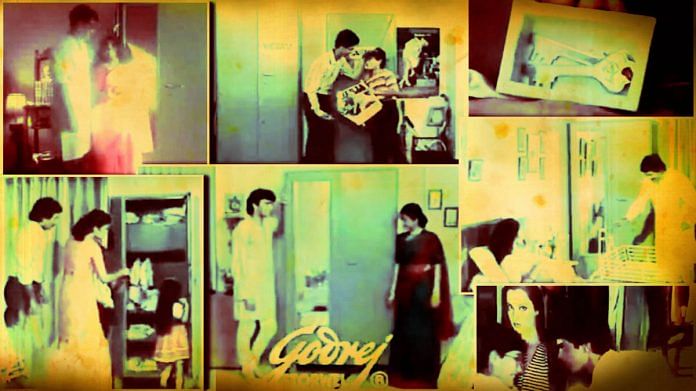Saajan ke aangan mein pehla kadam, Phoole ye bagiyaan mehke har dum; Aao miljul kar jahaan basaaein, Hum kuch aur jagah banaaein;
Storwel Godrej Storwel
The high-pitched voice and the old-fashioned language might seem out of place for many young urban Indians today, but for the pre-globalisation generations, the sentiment of the Godrej Storwel almirah ad was a truth universally acknowledged.
Godrej launched steel cupboards in 1923 as ‘The Godrej’, its third product after locks and soaps. The steel almirahs were later redesigned and rebranded as Godrej Storwel in the 1940s. With all its safety features, neat shelves and secure locks, the cupboard became extremely popular as wedding presents from parents to daughters.
This trend wasn’t lost on Godrej, and in the ’80s the company came out with this now iconic advertisement, featuring a young couple starting their new life together with the dream of creating a little space of their own.
The ad opens with the wedding ceremony, the bride looking down, coy. All through the pheras and the post-wedding games with the in-laws, she is shy and quiet, and keeps her gaze lowered. It is only when she and her husband are opening presents, and they open a box with a Godrej Storwel almirah key, that her face lights up. The ad ends with the two of them putting their things in the almirah and standing next to it, smiling at each other. It’s finally just the two of them, and in a sense, the ad underlines that even in a large joint family setup, it’s possible to have your own little haven of privacy.
“Back in the ’70s and ’80s, when most marriages were arranged between the parents, a woman would find herself at a new, strange place she couldn’t quite call her home yet. The Storwel became her own little corner,” says Kopal Kulkarni, former Design Lead at Godrej Innovation and Design centre.
He also notes how the almirah became immensely popular during weddings initially because of the exchange of jewellery and cash that weddings often entail — with its impeccable lock, the Storwel became the only place where people could safely store these things.
“With the right kind of push by an amazing sales and advertising team back then, it became a tradition to gift a bride or a newly wed couple a Godrej Storwel,” says Kulkarni reminiscing how the jingle hyphenated Godrej’s name with the product.
“It was so catchy that it became almost impossible to say Godrej without saying Storwel right after.”
Neelu Singh, a social activist from Agra, recalls that “rooms weren’t equipped with wardrobes and dressing rooms like they are today, they were just one portion of the house you were assigned with your husband”.
She says that the almirah, which she received as a wedding gift, “was a gift of privacy” in a time when most people didn’t even have attached bathrooms, forget independent kitchens and drawing rooms.
But it didn’t end at weddings. Godrej Storwel came out with a series of advertisements, all set to the same tune as the wedding one, but with slight variations to the lyrics. But the line “Hum kuch aur jagah banaaein” was a staple of most of them. In one, all the women of the family gift a pregnant woman an almirah; in another, two young boys, brothers, fight over space in their shared almirah — the conflict is resolved when the parents gift the younger one his own Godrej Storwel on his birthday. It was almost as if, in that one moment when he was given they key, he had come of age.
Changing times meant that these almirahs aren’t as much of a rage as they used to be. Where brides once stored trousseau saris and jewellery in their trusted almirahs, working couples now also need space for business suits and dresses, and with a proliferation of banks and therefore lockers, the need to store jewellery in the Godrej safe isn’t as pressing.
The iconic grey and olive green hold-alls have now given way to built-in modular wardrobe units. But for those who have grown up with a Godrej Storwel, it is difficult to imagine life without it, even if it is no longer used.
Like Shubham Kumar’s parents. The Navi Mumbai resident tells ThePrint that “Nobody uses the almirah anymore, it’s lying in one corner of the house. But my parents refuse to throw it away since it was the first thing they bought after getting married.”
Also read: Sorry Shaktimaan, it is Nagraj who was the first superhero of India



